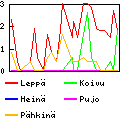Vendredi, 20 février 2009
Traduction: [ Google | Babelfish ]
Catégories : [ Informatique ]
I tried to use one of these wild devices to print a Letter landscape document
on microperforated Letter sheets… in an A4 world.
When the printer is set to use A4 paper, it won't pay attention to the
PostScript file telling it that the paper format is Letter. The result is
that the print would be correctly positioned on an A4 sheet, but is shifted up
the actual Letter sheet, because the letter sheet is aligned with the bottom
of the would-be A4 sheet.
The solution is to feed the beast only portrait documents, centered on an A4
page, then shift the document 2.5mm to the left to compensate for the fact
that it aligns the page's right border with the sheet's right border. This
gets it really centered on the Letter sheet (it should be 3mm to account for
the width difference between Letter and A4, but even A4 pages are shifted by
0.5mm; it would be too easy otherwise).
Finally, the bottom edge of the printed document is on the side of the back of
the beast (the one that is against the wall, opposite of the control panel).
This is important for the microperforated paper which has a smaller bottom
margin than the top margin.
[ Posté le 20 février 2009 à 17:04 |
4
commentaires |
lien permanent ]
Mercredi, 11 février 2009
Catégories : [ Râleries ]

Certains noms et marques n'ont l'air de rien dans une langue, et prennent un
sens tout différent dans une autre. Je connaissais déjà l'exemple de la Honda
MR2, renommée Honda MR pour le marché francophone. Voilà les Pätkis Mini Bites
de Fazer dont le nom aurait besoin d'être repensé si Fazer avait l'intention
de les vendre à des francophones.
[ Posté le 11 février 2009 à 18:42 |
pas de
commentaire |
lien permanent ]
Mercredi, 4 février 2009
Catégories : [ Cuisine ]
Deuxième expérience de yaourt.
Ingrédients
- 7,5 dL lait entier
- 2,5 dL yaourt turc 10% matière grasse
Préparation
Remplir le pot de yaourt et le verre doseur d'eau bouillante pour éliminer de
potentielles levures parasites (?). Battre le yaourt dans un verre doseur d'un
litre. Ajouter le lait peu à peu en mélangeant. Faire chauffer le mélange à
44 °C. Verser dans le pot. Placer le pot dans la
yaourtière et laisser reposer pendant 4
heures.
Commentaires
- Le yaourt a épaissi un peu mais reste très fluide. Il n'est pas granuleux
comme l'expérience précédente. Le passage
au réfrigérateur semble avoir eu une influence positive sur la gélification du
yaourt
- J'aurais dû passer la casserole à l'eau bouillante aussi, mais ça a marché
sans.
- Après réflexion, la yaourtière SEB semble ne rester allumée que pendant une
heure et laisse ensuite le yaourt refroidir lentement. C'est une voie à
explorer
[ Posté le 4 février 2009 à 23:25 |
pas de
commentaire |
lien permanent ]
Dimanche, 1er février 2009
Catégories : [ Cuisine ]
Premières expériences de yaourt en suivant les instructions de
l'INRA.
Ingrédients
Préparation
Battre le yaourt dans le pot d'un litre. Faire chauffer le lait à une
température telle que le mélange lait plus yaourt est aussi proche que
possible de 45 °C, mais inférieur à cette température (T = (45 - 0,2 x température
du yaourt) / 0,8 ). Verser un peu de lait chaud sur le yaourt et battre, puis
verser encore un peu de lait, etc. Ceci devrait permettre de mélanger le
yaourt au lait sans « cuire » le yaourt (et tuer les ferments). Placer le
pot dans la yaourtière et laisser
reposer pendant 3 – 4 heures.
Commentaires
- La température initiale était de 43 °C et la température finale de 44 °C, le
système de chauffage de la yaourtière est donc suffisant.
- La texture du yaourt, en revanche, est très fluide et granuleuse. Quelqu'un
a mentioné la présence de levures (non désirées) qui ont donné cet effet.
Sinon il peut s'agir du temps de préparation qui n'était pas assez long (3h30)
- On pourrait ajouter du lait en poudre dans le yaourt (mais je trouve que
c'est de la triche, après tout Valio arrive à faire son yaourt sans lait en
poudre), sinon on peut faire réduire le lait pour diminuer sa teneur en eau.
Faire bouillir le lait un certain temps est la méthode classique, mais elle
consomme beaucoup d'énergie. Faire bouillir à basse pression devrait permettre
de réduire la température d'ébullition et économiser beaucoup d'énergie, mais
je n'ai pas le matériel nécessaire.
[ Posté le 1er février 2009 à 22:53 |
pas de
commentaire |
lien permanent ]
Samedi, 31 janvier 2009
Catégories : [ Science ]
La préparation du yaourt est, en théorie, très simple: on mélange du lait et
du yaourt, on maintient à une température comprise entre 40 et 45 °C pendant
3 – 4 heures, et le tour est joué. Donc en théorie, une yaourtière est une
boite qui maintient la préparation à une température donnée.
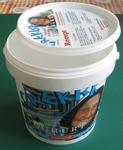
Pour des raisons pratiques, j'ai décidé de préparer mon yaourt en pot d'un
litre récupéré de yaourt industriels. J'ai toute une collection de pots vides
dans la cuisine, ça peut toujours servir.
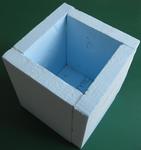
Ma première idée a été de fabriquer une boite isotherme (en polystyrène
extrudé de 30 mm d'épaisseur et collée) afin de conserver le lait chauffé à
45 °C à cette température assez longtemps pour que le lait se transforme.
Malheureusement, l'expérience a montré que la boite n'est pas suffisamment
isotherme pour ça. Des mesures ont montré qu'un litre d'eau à 43 °C perdait
approximativement 3 °C par heure les deux premières heures. Un rapide calcul a
montré que la boite émettait une puissance de 3 W.
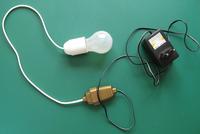
Je me suis donc décidé à construire un système de chauffage
d'approximativement 3 W. Après avoir étudié la possibilité d'utiliser du fil
de nichrome (il aurait fallu une trop grande longueur de fil très fin, donc
difficile à manipuler), je me suis rabattu sur l'utilisation d'une ampoule
électrique classique. Une ampoule de 100 W (sous 230 V) a une résistance à
froid d'environ 40 Ω, et devrait donc fournir environ 4 W sous 12 V.
Les premières expériences ont montré que l'ampoule chauffe en surface à
environ 60 °C du coté du filament, et nettement moins de l'autre coté. Le pot
de yaourt est en polypropylène qui fond à 140 °C, donc le pot ne risque rien.
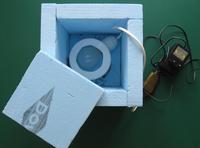
L'ampoule est placée au fond de la boite, sous un support destiné à recevoir
le pot de yaourt. Le support est constitué du fond d'un autre pot de yaourt
d'un litre, renversé et découpé pour en faire un trépied. Le fond de ces pots
est convexe, j'ai donc dû découper le centre afin que l'ampoule ne touche pas
le fond.
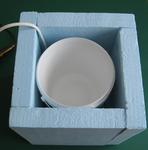
La boite avait été conçue à l'origine pour contenir le pot d'un litre plus une
boite de mascarpone de 2 dL qui devait contenir l'amorce de yaourt pour la
prochaine fournée. En fait, il ne faut pas fermer les pots, donc impossible
d'empiler simplement la petite boite sur le pot. Mais ça a laissé presque
suffisamment d'espace pour placer l'ampoule sous le pot et fermer le couvercle
à moitié.
[ Posté le 31 janvier 2009 à 12:02 |
18
commentaires |
lien permanent ]
Mercredi, 10 décembre 2008
Traduction: [ Google ]
Catégories : [ Science ]
Vedenkulutuksen jälkeen, mittaan
sähkönkulutusta:
- Pesukone (puuvillaohjelma, lisähuuhtelu, 40 °C): 78 min, 0.62 kWh, max 2 kW
[ Posté le 10 décembre 2008 à 21:26 |
1
commentaire |
lien permanent ]
Jeudi, 4 décembre 2008
Traduction: [ Google | Babelfish ]
Catégories : [ Râleries ]
This is somehting that needed to be said. Surprisingly, Google doesn't return
that many results for this sentence. Is it stil a taboo? (Taboo, on the Web?
Who am I kidding?)
[ Posté le 4 décembre 2008 à 09:44 |
pas de
commentaire |
lien permanent ]
Mercredi, 3 décembre 2008
Traduction: [ Google ]
Catégories : [ Science ]
Uusi vesimittari inspiroi mittaamaan vedenkulutusta:
- Vessan vetäminen: 7 L
- Tiskikone (ilman esipesua): 18 L
- Pesukone (puuvillaohjelma, lisähuuhtelu): 74 L
- Suihku: 85 L
[ Posté le 3 décembre 2008 à 23:14 |
pas de
commentaire |
lien permanent ]
Lundi, 1er décembre 2008
Traduction: [ Google ]
Catégories : [ Râleries ]
Tänä aamuna joku mies tuli kotiini juuri kun olin lähtemässä. Hän sanoi
tulleensa vaihtamaan vesimittarin. Hänen pakettiautonsa kyljessä oli kyllä
Jyväskylän Energian logo (eli valtava mainoskuva kahviautomaatista tai
jotain, ja pieni teksti, jossa luki “Jyväskylän Energia”). Mikä vesimittari? En
ole pyytänyt ketään vaihtamaan mittaria. Miksi se tarvitsee vaihtaa? Mutta niin se on:
vesimittari vaihdetaan joka viides vuosi. Ei kerrota asiakkaalle että joku
tulee, hän vain tulee. En tiedä mitä hän tekee, jos kukaan ei ole kotona.
Mutta mittari on nyt vaihdettu, ja vanha lukema (jonka olisin kirjoittanut tänä
iltana tilastooni) on hukassa.
[ Posté le 1er décembre 2008 à 22:09 |
pas de
commentaire |
lien permanent ]
Samedi, 29 novembre 2008
Traduction: [ Google | Babelfish ]
Catégories : [ TV/Leffakone ]
Leffakone's timer's been working
perfectly for almost two years, but since we moved, it doesn't always
work as it should. The LED goes off when it starts to receive data (as
expected), but then it just reboots (because of the watchdog timer) and then
waits for data again (its LED on). But it will not accept the data anymore.
And after a couple of days, for no reason, it works again (and blinks happily
while counting down).
I took it to the telecom lab last Tuesday and Niko took a look at it. The
solders seem fine. We changed the micro-controller and flashed it. It still
behaved erratically on the bench, rebooting repeatedly for no obvious reason,
sometimes receiving data with the available signal low but touching the
data wire with the finger (I mean the insulation of the wire, not the
metallic part). Niko unsoldered and resoldered the crystal, thinking it was
faulty, with no effect. It seemed doomed.
Then I took it back home, checked with an ohm-meter that all the resistors
were resisting, that the capacitors were capaciting, and I put it back in
Leffakone. This was last Thursday. Since then, it's been working perfectly…
[ Posté le 29 novembre 2008 à 23:36 |
pas de
commentaire |
lien permanent ]
Samedi, 15 novembre 2008
Catégories : [ Râleries ]
Lorsqu'on envoie une lettre depuis l'étranger vers la Finlande, on
préfixe le code postal
par « FI- ». Pas « FIN- » ni « SF- » . Lorsqu'on envoie une lettre
depuis l'étranger vers la France, on ne fait
pas précéder le code
postal par un quelconque code.
Kun lähetetään kirje ulkomailta Suomeen, postinumeron eteen
kirjoitetaan “FI-”.
Ei “FIN-” eikä “SF-”. Kun lähetetään kirje ulkomailta Ranskaan, ei
kirjoiteta mitään
postinumeron eteen.
[ Posté le 15 novembre 2008 à 21:23 |
6
commentaires |
lien permanent ]
Mardi, 11 novembre 2008
Traduction: [ Google | Babelfish ]
Catégories : [ Informatique ]
I fixed a bug in xautoaway
(actually, in X11::Protocol). The new
version is available.
[ Posté le 11 novembre 2008 à 23:46 |
pas de
commentaire |
lien permanent ]
Catégories : [ Blog ]
I changed my RSS feed so that it displays the stories in HTML instead of the
old text-only version. Moreover, I added a link to each of the RSS items to
use automatic translating services (Google Translate and Babelfish). This link
only appears if the RSS feed is requested with a given language in parameter.
E.g., for English, use http://users.jyu.fi/~mweber/blog/index.rss?lang=en as
the RSS feed's URL. You can replace the en at the end with fr or fi for
French and Finnish respectively.
J'ai changé mon flux RSS afin d'afficher les histoires en HTML au lieu de
l'ancienne version en texte simpe. De plus, j'ai ajouté à chaque item RSS un
lien vers des services de traduction automatique (Google Translate et
Babelfish). Ce lien n'apparait que si le flux RSS est appelé avec un paramètre
langue. Par exemple pour le Français, il faut utiliser
http://users.jyu.fi/~mweber/blog/index.rss?lang=fr comme URL du flux RSS. On
peut remplacer le fr à la fin par en ou fi pour l'anglais ou le finnois,
respectivement.
Disclaimer — Désistement
I cannot be held responsible for death by fatal
hilarity when reading the
automatic translations.
Je ne peux être tenu responsable si vous mourez de rire en lisant les
traductions automatiques.
[ Posté le 11 novembre 2008 à 23:35 |
pas de
commentaire |
lien permanent ]
Mercredi, 5 novembre 2008
Traduction: [ Google | Babelfish ]
Catégories : [ Informatique ]
xautoaway.pl is an
autoaway script for Irssi that allows Irssi to go
away automatically when your X Window session has been idle for some time.
Additionaly, it supports Irssi running in a GNU screen, being detached from an
xterm in one display and reattached to another xterm on another display.
Distributed as-is, under “it-works-for-me” pseudo-license (and under GNU
GPLv3 real license).
It requires the X11::Protocol module and some additional setup (the provided,
incomplete extension to X11::Protocol to support MIT-SCREEN-SAVER and the
screen wrapper to be run instead of GNU screen).
[ Posté le 5 novembre 2008 à 23:40 |
pas de
commentaire |
lien permanent ]
Mardi, 4 novembre 2008
Traduction: [ Google ]
Catégories : [ Science ]
Bensa maksaa Keljon Shell Expressillä 1,294 EUR, mutta Palokassa se maksaa
vain 1,259 EUR Palokan Neste Oil Expressillä. Matka Palokkaan ja takaisin on
noin 20 km. Auto käyttää noin 7 L/100km, siis 1,4 L bensaa, joka maksaisi
1,76 EUR. Tankkaan 35 L, hinta ero on siis 0,88 EUR. Se ei maksaa vaivaa.
(datan lähde: polttoaine.net).
[ Posté le 4 novembre 2008 à 22:43 |
1
commentaire |
lien permanent ]
Traduction: [ Google | Babelfish ]
Catégories : [ Informatique ]
I just finished
motdictd.pl a
gateway between the DICT
protocol and the MOT online
(not free at all) dictionary collection accessible to the University of
Jyväskylä. It runs as a local DICT server, started from the command line by
any user (preferably not root) and listens to 127.0.0.1 on port 2628. DICT
queries are turned into HTTP requests to NetMOT, the resulting HTML code is
cleaned up and returned as pure text to the DICT client. The CLI DICT client
doesn't support multiple servers, so it accessing the gateway requires to call
dict -h localhost if the default server is dict.org.
[ Posté le 4 novembre 2008 à 11:09 |
1
commentaire |
lien permanent ]
Jeudi, 30 octobre 2008
Catégories : [ Science ]
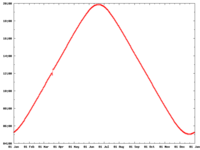
Jyväskylä se situe à 62.22°N, 25.73°E. Le graphique ci-contre représente la
durée du jour en 2008 en fonction de la date (du 1er janvier au 31 décembre).
Le défaut aux alentours de l'équinoxe est probablement dû à une problème
d'arrondi et au fait que les calculs prennent l'équinoxe pour point de départ.
Je ne m'attendais pas à ce que la courble soit aussi linéaire à distance des
solstices, ni qu'elle soit aussi « pointue » aux solstices.
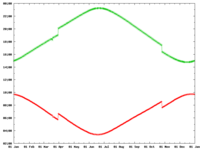
Ici, les heures de lever et de coucher du soleil. Le décalage fin mars et fin
octobre sont dûs au passage à l'heure d'été et au retour à l'heure d'hiver.

Beaucoup plus étrange ici, le midi solaire (mi-chemin entre le lever et
coucher du soleil) n'est pas à un intervalle de temps constant du midi civil
comme on pourrait s'y attendre. Encore plus étrange, cette courbe a deux
maxima et deux minima qui ne sont pas au même niveau et qui ne correspondent
pas à des dates clés. Les points d'inflexion, en revanche, semblent situés aux
solstices et aux équinoxes.
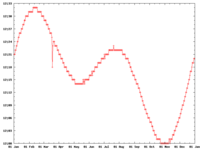
Ici la même courbe sans le passage à l'heure d'été pour davantage de
lisibilité. La forme en « escalier » de la courbe est dûe à la précision des
valeurs calculées, qui est limitée à la minute. On remarque en particulier que
le décalage entre les midis solaire et civil varie entre 0 et 32 minutes, avec
un décalage moyen d'environ 18 minutes lus sur le graphe (17 minutes par
calcul si on considère le décalage en longitude entre Jyväskylä et le centre
du fuseau horaire à 30.00°E).
[ Posté le 30 octobre 2008 à 23:42 |
pas de
commentaire |
lien permanent ]
Mardi, 28 octobre 2008
Catégories : [ Thé ]
Thé vert, grandes feuilles torsadées. Les feuilles sèches on un parfum fruité
(abricot sec) et peut-être un peu grillé. L'infusion est plus verte, assez
douce et peut-être un peu fruitée (abricot sec encore une fois).
[ Posté le 28 octobre 2008 à 10:13 |
pas de
commentaire |
lien permanent ]
Lundi, 27 octobre 2008
Traduction: [ Google | Babelfish ]
Catégories : [ Informatique ]
I just tested Synergy. This little tool
allows to share one keyboard and mouse between several computers sitting next
to each other (that is, each computer needs to have its own display) over the
network. When the mouse cursor reaches the edge of the screen, it moves to the
screen of the computer next to that edge (and the keyboard's focus too, of
course). The great thing is that it works in Linux (and other Unices), in
MacOS X and in Windows. So it's perfectly possible to have a mix of all these
types of systems, and it woks seamlessly, without any extra hardware.
[ Posté le 27 octobre 2008 à 22:47 |
pas de
commentaire |
lien permanent ]
Samedi, 25 octobre 2008
Catégories : [ Science ]
J'ai reçu aujourd'hui (enfin hier, vu l'heure qu'il est) la carte
topographique au 1/20 000è de Jyväskylä que j'avais commandée mercredi soir.
Service rapide !
Voici donc deux courbes de niveau pour un trajet Hinkalo — Agora, en voiture
et à vélo (les chemins parcourus sont totalement différents). Le dénivelé
total est de 93 m.
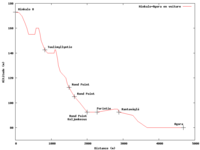
Le trajet en voiture est long de 4680 m. Du point de départ au rond point de
Keljonkeskus situé entre les deux supermarchés, le dénivelé est de 80,5 m pour
une distance parcourue de 2000 m, ce qui fait une déclivité moyenne de 4%, mais
avec des pointes à 14% sur Tuulimyllyntie et 13% sur Myllyjärventie.
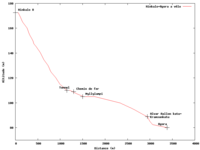
Le trajet en vélo est long de 3380 m. Du point de départ jusqu'au petit
tunnel, la déclivité moyenne est de 5,7%, mais avec peu de variation sur ces
1100 m de trajet.
[ Posté le 25 octobre 2008 à 00:48 |
pas de
commentaire |
lien permanent ]
Mercredi, 22 octobre 2008
Traduction: [ Google | Babelfish ]
Catégories : [ Informatique ]
This is the follow-up to the previous
episode.
Today's discussion with Ville was concluded more or less like that: he claimed
that having access to the source code is of no use for him although he can
code, because he has never been able to gather the necessary energy to start
hacking an existing software. Well, that's his problem, isn't it? I devote
some of my free time to hack software (in a very insignificant way, I'm sure)
to adapt it to my needs, he devotes his to something else. And I enjoy my
small software hacks. I'm proud of myself when I manage to understand
MPlayer's subtitles code and add support for DVB subtitles, or when I add
support for X11's screensaver protocol to perl's X11::Protocol module. And
let's be honest: LATEX is ridiculously complicated, but
I enjoy fighting the beast and bending it to my will.
I have loads of fun doing things myself. I make my own pizzas from scratch
(dough and tomato sauce, altough I don't grow the tomatoes, olives and wheat,
nor do I breed pigs or milk cows), I make my own ice-cream, my own Home
Theater PC, my own blog engine, my own Carcassonne meeples. Buying something
ready-made feels like a waste of money if I can do it myself for a reasonnable
cost in time. I'm not going to devote large amounts of time on large projects
such as writing my own operating sytem, word processor or image manipulation
software, mainly because the time it would cost me compared to the benefit I
would get out of it compared to using the existing tools is not worth it.
Hacking oversized projects don't really interest me, even if they have bugs
and I'd like to fix them. But I very much appreciate that small, one-person
-sized softwares are free for me to hack when I set my mind to it.
The ones who consider the freedom given by free software to be useless are the
ones who are too busy/lazy to take advantage of it and have more money at hand
than time.
[ Posté le 22 octobre 2008 à 23:41 |
9
commentaires |
lien permanent ]
Traduction: [ Google | Babelfish ]
Catégories : [ Informatique ]
This is the follow-up to the previous
episode.
So, is free software always better than the other kind? Jonne claimed
that the “freedom” aspect of free software isn't an advantage for him,
because free software is hard to change, and it takes a long time to implement
the new feature you would like to add to it. The alternative would be to send
a bug report or feature request to the developers. But both in free project
and proprietary ones you may reach grumpy developers, who will consider your
request as low priority.
Now the real difference between free and proprietary is that in the case of
free software, you have the right to do it yourself. It may be difficult and
take an enourmous amount of time (such as integrating CMYK in GIMP, which was
not designed orginally to handle anything else than RGB), but it is possible
if you are willing to devote resources (time and/or money) to it. With a
proprietary software, if the developers don't want to implement your feature,
there is no appeal. Jonne's argument was that you can always find a software
(free or not) that does what you want. I claim that this is not always true.
The first example is that when I built my leffakone five years ago, there was
no software running on Linux that supported DVB subtitles and automatic TV
commercial removal. Actually, there was no software that was supporting these
two features at all. So I took the time to implement them myself (and yes,
MPlayer's subtitle code is an horrible mess). The second example is a recent
problem with Python's X11::Protocol module. It had a bug that I managed to
identify thanks to the source code, and I found a way to go around it. I
submitted a bug report, but to this day (over a month later) it has still not
been answered. X11::Protocol was exactly what I needed, but had it been
proprietary, I wouldn't have been able to find a workaround, and would have
needed to settle with a sub-optimal solution, which would not have been doing
exactly what I want.
Jonne also claimed that developers don't need the source code of a software,
but the software should be designed so that it can be extended. Firefox is a
good example: a lot of features can be added as “extensions” and the
developers don't need to access Firefox's source code. But not all software is
designed to be extensible, especially if it is in the (financial) interest of the
publisher to prevent anyone to develop an extension without its blessing. This
means that if the extension you want to develop doesn't follow the publisher's
commercial strategy, you won't be allowed to do it. And again there will be no
appeal. An no, you don't always find another software that does the same
thing and would allow you to develop your extension.
And guess what? Most of the software available nowadays is not extensible.
That is, it's not meant to be easy to extend. If you want to change its
behavior or fix a bug, you have no choice but to dig into the source code. And
even if the software has been designed with extensibility in mind, it doesn't
mean that the data it exports through its extension API contains all the
information you need for your purposes. A good example of this if my blog
engine, Bloxsom. It was designed to be extensible, most of the work is done
by extensions rather than by the software's core. But for implementing
features such as multiple languages and multiple categories, I had to change
the core, because the extension API was not enough. And I don't know any other
blog engine that fits my requirements. But hey, I don't know all the blog
engines in the world, so I may be wrong.
To be continued.
[ Posté le 22 octobre 2008 à 23:14 |
pas de
commentaire |
lien permanent ]
Traduction: [ Google | Babelfish ]
Catégories : [ Informatique ]
I started to use free software in 1996 (or was it 97?), with Slackware 3.0.
The first reason why I decided to learn Linux is because Unix systems were the
ones used by real coders. Windows already looked too much like a toy, had
the bad reputation of a shaky house built over the sand of MS-DOS. And also
because it was cool (from a geek's perspective, of course). The reason why I
continued to use free software was that even though free software is free as
in “free speech”, it is also free as in “free beer”. There were software
filling my needs, and I adapted the topic of my free-time projects to what was
available on Linux. For example, I could have continued to play aimlessly with
SoundForge in Windows, but coding an IRC bot in Perl on Linux was more
appealing. It was a creative process, the creation of somethat that acts (if
only by reflex), on the contrary of something you contemplate with more or
less awe (like music or a painting). And also, the IRC bot was working on my
behalf, providing a service.
I had a long discussion with two colleagues the other morning, who claimed
that Free Software is a fad. I didn't agree with them at first, thinking about
the origins of the free software movement, but after reflection I have to
admit that in the last five years it actually has turned into a fad. Not a
passing fad like clothing fashion (although the pointy shoe fashion could have
changed more quickly for my taste), but in the sense of something that a lot
of people use, and who use it because everybody else is also using it. The
reason for this is that free software is free (as in “free beer”) and people
are more often than not choosing something free over something they have to
pay for. The average software user doesn't care whether he has the right to
modify software or not. He's a user, not a developer, and he doesn't know how
to use this right. I guess plenty of users still use warez software or free
(as in “beer”) proprietary software instead of free software, because warez
doesn't cost more than free software (at lease from the point of view of
money). In some cases, one free (as in “speech”) software can drive the fad.
This is the case of Firefox I guess, which was in its time technically
superior to Internet Explorer (it respected the standards of the Web and had
popup and ad blockers). And I wouldn't be surprised that Firefox has been the
main driving force behind the free software fad.
To be continued.
[ Posté le 22 octobre 2008 à 22:32 |
pas de
commentaire |
lien permanent ]
Mardi, 21 octobre 2008
Catégories : [ Science ]
Suite de l'épisode précédent.
J'ai passé aujourd'hui un certain temps à discuter de mécanique auto avec
Henrik et en particulier de la consommation rélle d'une voiture. On a fini par
en revenir au problème de trouver la courbe de consommation spécifique des
moteurs de nos voiture, mais il semble que les constructeurs tiennent à
garder ces informations secrètes… En revanche, Henrik a trouvé un
article en allemand de
Helmut Tschöke et Hanns-Erhard Heinze publié dans le Magdeburger
Wisseschaftsjournal de 2001 qui compare les consommations de divers types de
moteurs (essence, essence à injection directe, diesel à injection directe pour
voitures personnelles et les véhicules utilitaires).
Les auteurs indiquent entre autres qu'étant données les masses volumiques et
les densités énergétiques différentes entre l'essence et le diesel, à
consommations énergétiques égales, le moteur diesel a une consommation
moyenne inférieure. Cependant le diesel produit davantage de CO2
que l'essence, à consommations égales. Mais les consommations moyennes des
voitures à essence et diesel ne sont justement pas égales.
Un peu plus loin, ils se demandent s'il est possible de construire une voiture
qui consomme seulement 1 ou 2 L/100 km (la Volkswagen Lupo 3L a été conçue
pour ne consommer que 3 L/100 km en moyenne) et concluent que ce n'est pas
possible, mais qu'on pourrait descendre à 2 ou 2,3 L/100 km.
Les auteurs introduisent finalement la notion de facteur de mobilité (FM),
égal au produit de la consommation par le temps nécessaire à la parcourir
divisé par le nombre de personnes transportées. Sur un trajet de 300 km, le
piéton a un FM de 30, le vélo 7, la voiture 7,8, le car 1,4, le train 1,6 et
l'avion 5,5 (le piéton consomme l'équivalent de 0,5 L/100 km et le vélo 0,35).
Ma voiture a un FM de 6,1 avec 4 passagers et 8,1 avec 3
passagers.
[ Posté le 21 octobre 2008 à 22:39 |
pas de
commentaire |
lien permanent ]
Catégories : [ Thé ]
Thé vert, uniquement fait de petites feuilles courtes (bourgeons?). Les
feuilles sèches ont une odeur qui me rappelle le chocolat noir 72% de
Kalev. La première infusion est orange
pâle et a un goût de riz soufflé. Après, c'est plus flou.
[ Posté le 21 octobre 2008 à 10:27 |
pas de
commentaire |
lien permanent ]
Mercredi, 15 octobre 2008
Traduction: [ Google | Babelfish ]
Catégories : [ Informatique ]
FOAF means Friend of a Friend. It's an RDF
vocabulary that allows to describe oneself and
link to people one knows. In other words, it forms a distributed social
network, independant from any service provider such as Facebook, LinkedIn,
Orkut and so on. It doesn't allow you to send messages to other people in your
network, or any of the activities that are often associated with social networks,
it only describes you and your relations to the people you know.
Here's my FOAF descriptor, that you
can also view through FOAFer.
There's also FOAF-a-Matic, a simple web tool
that creates a basic FOAF descriptor for you (a more advanced descriptor will
required to write RDF by hand, though). Finally, there is also a FOAF
Generator
that creates a FOAF descriptor based on your Facebook profile.
So if you feel geeky enough to get your own FOAF descriptor and if you know
me, let me know about it :)
[ Posté le 15 octobre 2008 à 15:43 |
pas de
commentaire |
lien permanent ]
Vendredi, 10 octobre 2008
Traduction: [ Google | Babelfish ]
Catégories : [ Science ]

I've been thinking how to automatise the process of setting the car engine's heating
time in the morning depending on the outside temperature. Since heating is not overly expensive,
I've decided that a cheap timer switch should do the trick. As to how long
the engine should be heated… Well, statistics may help here. The graphs on
the left represents the average temperature in the morning at 6 and at 8 over
the past 6 years (2002 – 2008). From the graph, it's easy to see that there are
clear periods where the temperature is between this and that limit.

In a nutshell and in month-day format:
- 01-01 – 03-01: 2 hours
- 03-01 – 03-25: 1 hour
- 03-25 – 05-01: 30 minutes
- 05-01 – 10-01: no heating
- 10-01 – 12-15: 30 minutes
- 12-15 – 12-31: 1 hour
This represents 214 hours of heating in the year, amounting to 6.90 EUR (with
a 400 W heater, and a rate of 0.08 EUR/kWh). With the additional inside
heater (add 950 W), it costs 23.30 EUR. This is almost 40% more expensive than
the optimised calculation in the previous article, but a device combining
termperature sensor with a clock is hard to find and will cost 50 to 100 EUR,
when a mechanical clock switch can be found for 5 EUR.
[ Posté le 10 octobre 2008 à 23:55 |
1
commentaire |
lien permanent ]
Catégories : [ Science ]
On conseille de chauffer la voiture si la température de l'air descend en
dessous de 5 °C. La durée de chauffage varie en fonction de la température:
- 5 °C à -5 °C: 30 minutes
- -5 °C à -10 °C: 60 minutes
- < -10 °C: 120 minutes
En 2007, la température le matin à 8 heures était:
- < 5 °C et > -5 °C pendant 159 jours
- < -5 °C et > -10 °C pendant 23 jours
- < -10 °C pendant 33 jours
Ceci nous fait 168 heures de chauffage sur l'année (en comptant les
week-ends), donc à 400W de puissance de chauffage et à 0,08 EUR le kWh, ça nous
fait 5 EUR par an. Si on rajoute le chauffage de l'habitacle (950W), on arrive
à 18 EUR par an.
[ Posté le 10 octobre 2008 à 08:13 |
pas de
commentaire |
lien permanent ]
Dimanche, 5 octobre 2008
Catégories : [ Cuisine ]
Ingrédients
- 100g pistaches épluchées, non-salées
- 100g sucre glace
- 1 blanc d'œuf
Préparation
Mixer les pistaches avec le sucre jusqu'à obtention d'une poudre fine. Ajouter
le blanc d'œuf et mélanger à la cuillère (le mélange devient trop épais pour
le mixer).
[ Posté le 5 octobre 2008 à 14:00 |
pas de
commentaire |
lien permanent ]
Jeudi, 2 octobre 2008
Catégories : [ Râleries ]
<noursy> qu'est-ce que ça change pour le commun des mortels qu'on
descende du singe ou d'Adam ?
<loupi> ben on saurait s'il faut manger des bananes ou des pommes :)
[ Posté le 2 octobre 2008 à 16:16 |
pas de
commentaire |
lien permanent ]
Samedi, 27 septembre 2008
Traduction: [ Google | Babelfish ]
Catégories : [ Jeux ]
The font used in the Blue Moon cards (FFG edition) is ITC Kallos, size 12.5pt
(or 12pt?) medium and bold, and 8pt book italic for the flavour text.
The font used on the expansion decks' tuckboxes is Bitstream Flareserif.
[ Posté le 27 septembre 2008 à 00:17 |
pas de
commentaire |
lien permanent ]
Dimanche, 21 septembre 2008
Traduction: [ Google | Babelfish ]
Catégories : [ Jeux ]
The Phar is one Blue Moon people that has been
mentionned (in Emissaries and Allies: Blessings
and in the prologue of the Blue Moon Novel)
but never developed as a deck. Their names derives from “Pharao”, so the
theme will be Egypt-like. If I ever have a wonderful idea about what features
to put in that deck, I'll try to develop it myself.
[ Posté le 21 septembre 2008 à 19:09 |
pas de
commentaire |
lien permanent ]
Traduction: [ Google | Babelfish ]
Catégories : [ Bricolage ]
Gasoline is expensive, at a current price of about 1.50 EUR/L it costs me
currently 950 EUR/year. Especially now that I live closer to work, the
consumption is higher because the trip is so short.
The previous plan was to get an electric car, but it would cost a lot and need
to keep the old car for longer trips (for example I wouldn't trust the e-car
to take us to Tampere, wait 4 weeks on the airport's long-term parking lot and
drive us back home). That means more insurance costs, parking space worries
and so on.
The current plan is to build a recumbent trike
based on one (or two?) old (or new) bycicles. Ready-made devices cost about
2,500 EUR (with one exception at 900 EUR, that's suspicious), home-made may
take years to build (I have to learn welding first, but Reijo would probably
be happy to teach me) but it may cost less than 500 EUR. Such a trike would be
perfect for going to work daily, although coming back from work maybe
difficult without electrical assistance (the hill back home is definitely steep).
Another requirement would be to have a protection from rain and snow, and
ready-made such trikes cost 4500 EUR (5500 EUR with electrical assistance,
that's over 5 years of gasoline at current rate). I have no idea how to build
a hull for a trike (most people building trikes seem to live in countries
where snow and cold is something that happens to other people). Also, it needs
to support an extra seat for a child (this one could be mounted over the back
wheel, but getting it below the hull will be difficult.
[ Posté le 21 septembre 2008 à 19:03 |
pas de
commentaire |
lien permanent ]
Catégories : [ Cuisine ]
Composition de l'œuf (balance de cuisine, précision: 2g) :
- masse : 66g
- coquille : 8g
- jaune : 20g
- blanc : 35g
[ Posté le 21 septembre 2008 à 18:24 |
2
commentaires |
lien permanent ]
Jeudi, 18 septembre 2008
Traduction: [ Google ]
Catégories : [ Râleries ]

© Ingman.fi
Nyt kun on taas kesä, kun mennään iltapäivällä ostoksille ostetaan jäätelöitä
välipalaksi. Mutta taas tänä vuonna jäätelötekijät eivät ole ymmärtäneet että
jos pakkauksessa lukee “Suklaa”, pakkauksen sisällä ei pitäisi olla
vaniljajäätelöä. Vanilja on aika hyvää, mutta se ei ole sama kuin suklaa. Ne
ovat helppoja erottaa: suklaajäätelö on ruskeaa, kun taas vaniljajäätelö on
valkoista. Helppo juttu. Tai niin voisi luulla. Monissa Valio-, Ingman- mutta
myös Magnumjäätelöpakkauksissa lukee esim. “suklaa”, “nougat”, “manteli”
jne. mutta pakkauksesta löytyy vain vaniljajäätelöä, jossa on muutama prosenttia
suklaata, nougatpaloja tai mantelia. Jos et usko minua, lue jäätelön
ainekset:
vain koristeessa on kaakaota. Jäätelössä ei ole sitä.
Eikö ole lakia joka kieltaa harhajohtavan mainonnan?
[ Posté le 18 septembre 2008 à 13:38 |
pas de
commentaire |
lien permanent ]
Mardi, 16 septembre 2008
Traduction: [ Google | Babelfish ]
Catégories : [ Science ]
findlocalweather.com
has “real-time” graphical data about temperature, humidity, pressure and wind
speed for Europe (and other parts of the World too). Nice.
Links to maps for
Temperature,
Humidity,
Pressure,
Wind speed.
[ Posté le 16 septembre 2008 à 14:21 |
pas de
commentaire |
lien permanent ]
Traduction: [ Google | Babelfish ]
Catégories : [ Blog ]
I implemented menus for the category list, because it was uselessly long.
Items that contain subitems are in bold font. Anyway, indenting subcategories
with non-breakable spaces has been annoying me for a long time, but I never
had a good reason to rewrite the categorytree module to get rid of them.
It seems that making a menu was a good enough reason.
The mechanism for the menu (using purely CSS) is adapted from Eric Meyer's
Pure CSS Menus. I have no
idea if it works with IE (at the time Meyer implemented his menu in 2002, IE's
CSS engine was too crappy to render them properly), but who cares about IE
users anyway.
[ Posté le 16 septembre 2008 à 00:32 |
pas de
commentaire |
lien permanent ]
Vendredi, 12 septembre 2008
Traduction: [ Google | Babelfish ]
Catégories : [ Blog ]
I removed the RANDOM spam filter (comparing letter frequences of a comment
with statistics for English, French and Finnish). It wasn't catching much spam
anyway, and the one it did catch was not random, but contained lots of
medicine names, which don't follow the statistical patterns of English, French
or Finnish. And also, it did filter out one legitimate comment where the
author's name was Finnish and the content was in English (thus matching
neither Finnish nor English statistics), which is not nice.
[ Posté le 12 septembre 2008 à 16:46 |
2
commentaires |
lien permanent ]
Mercredi, 10 septembre 2008
Traduction: [ Google | Babelfish ]
Catégories : [ Blog ]
A closer look at the spams shows that in the
past 3 weeks, 100% of the comment spam has been caught. The messages that I
needed to moderate manually were all trackback spam. The latter is harder to
spot because there is no form that should be fetched prior to posting and that
could be used for laying traps.
Comment spam represent 64.1% of the spams, whereas trackback spam represents
35.9% (with a total of 139303 spams in 795 days i.e., an average of 175 spams
per day).
Given the amount of legitimate trackback I get (exactly 0 in two years), maybe
I should simply disable it?
[ Posté le 10 septembre 2008 à 23:25 |
pas de
commentaire |
lien permanent ]
Traduction: [ Google ]
Catégories : [ Râleries ]
“Koneellisesta hillotuksesta johtuen munkista saattaa puuttua hillo.”
(Elosen sokerimunkkien pakkauksesta)
Eli jos sinulla on hillomunkki jossa ei ole hilloa, se on silti hillomunkki.
Toisin sanoin, kun teet hillomunkkia, et tarvitse hilloa.
[ Posté le 10 septembre 2008 à 18:57 |
pas de
commentaire |
lien permanent ]
















